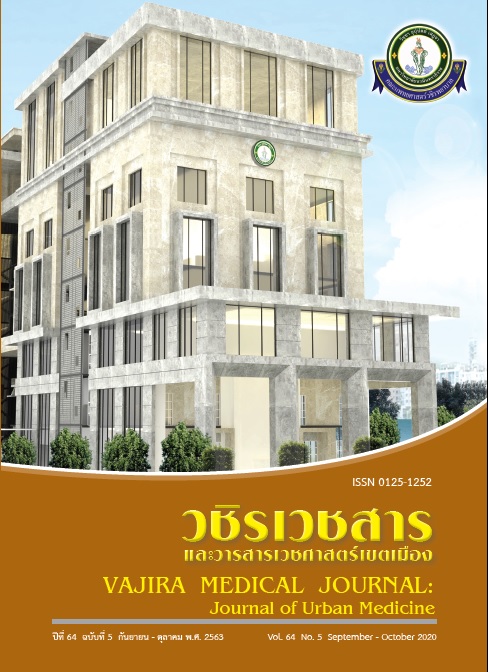Patency Rate of Superficial Temporal Artery-Middle Cerebral Artery Bypass in Vajira Hospital
Main Article Content
Abstract
Objective: To describe and evaluate the patency rate of superficial temporal artery-middle cerebral artery (STA-MCA) bypass for treatment of patients with cerebrovascular diseases and brain tumors at Vajira Hospital.
Methods: This was a retrospective descriptive study in patients with cerebrovascular diseases and brain tumors who received STA-MCA bypass at Faculty of Medicine Vajira Hospital between May 2015 and September 2019. Type of diseases, bypass techniques (single or double bypass) and bypass patency were collected from medical records. The surgical techniques and one illustrative case were also described.
Results: Thirty-three patients received STA-MCA bypass for 37 operations and 55 anastomoses. Operations with single bypass and double bypass were 51.4 and 48.6%, respectively. The most common indication for STA-MCA bypass was intracranial aneurysms (37.8%). Patency rate were 94.6% and 92.7% for number of operations and anastomoses respectively. For single bypass, patency rate was 89.5%. In cases of double bypass, patency rate were 100% and 94.4% for number of operations and anastomoses respectively.
Conclusion: With our knowledge, this study is the research that report the highest number of STA-MCA bypass procedure and is the first issue to study the patency rate of STA-MCA bypass in Thailand. STA-MCA bypass has a high patency rate in immediate period (within 48 hours) after surgery, especially for double bypass.
Downloads
Article Details
References
Yasargil MG (ed): Microsurgery Applied to Neurosurgery. Stuttgart: Georg Thieme: 1969.
Vilela MD, Newell DW. Superficial temporal artery to middle cerebral artery bypass: past, present, and future. Neurosurg Focus 2008;24(2):E2.
Newell DW. Superficial temporal artery to middle cerebral artery bypass. Skull Base 2005;15(2):133-41.
Charbel FT, Meglio G, Amin-Hanjani S. Superficial temporal artery-to-middle cerebral artery bypass. Neurosurgery 2005;56(1 Suppl):S186-90.
Wanebo JE, Zabramski JM, Spetzler RF. Superficial temporal artery-to-middle cerebral artery bypass grafting for cerebral revascularization. Neurosurgery 2004;55(2):395-8.
Lawton MT, Hamilton MG, Morcos JJ, Spetzler RF. Revascularization and aneurysm: Current techniques, indications, and outcome. Neurosurgery 1996;38(1):83-92.
Spetzler RF, Schuster H, Roski RA. Elective extracranial-intracranial arterial bypass in the treatment of inoperable giant aneurysms of the internal carotid artery. J Neurosurg 1980;53(1):22-7.
EC/IC Bypass Study Group. Failure of extracranialintracranial arterial bypass to reduce the risk of ischemic stroke. Results of an international randomized trial. N Engl J Med 1985;313(19):1191-200.
Grubb RL Jr, Powers WJ, Derdeyn CP, Adams HP, Clarke WR. The Carotid Occlusion Surgery Study. Neurosurg Focus 2003;14(3):e9.
Nussbaum ES, Erickson DL. Extracranialintracranial bypass for ischemic cerebrovascular disease refractory to maximal medical therapy. Neurosurgery 2000;46(1):37-42.
Sekhar LN, Kalavakonda C. Cerebral revascularization for aneurysms and tumors. Neurosurgery 2002;50(2):321-31.
Thanapal S, Duvuru S, Sae-Ngow T, Kato Y, Takizawa K. Direct Cerebral Revascularization: Extracranial-intracranial Bypass. Asian J Neurosurg 2018;13(1):9-17.
Tokugawa J, Ogura K, Yatomi K, Kudo K, Hishii M, Tanikawa R, et al. Bipolar Cutting Method: Another Technique for Harvesting Donor Artery With Histological Investigation. Oper Neurosurg (Hagerstown) 2018;14(1):16-9.
Sekhar LN, Natarajan SK, Ellenbogen RG, Ghodke B. Cerebral revascularization for ischemia, aneurysms, and cranial base tumors. Neurosurgery 2008;62(6 Suppl 3):S1373-408.
Hafez A, Buçard JB, Tanikawa R. Integrated Multimaneuver Dissection Technique of the Sylvian Fissure: Operative Nuances. Oper Neurosurg (Hagerstown) 2017;13(6):702-10.
Katsuno M, Tanikawa R, Izumi N, Hashimoto M. The preparation of anastomosis site at the insular segment of middle cerebral artery. Surg Neurol Int 2014;5:85.
Ishishita Y, Tanikawa R, Noda K, Kubota H, Izumi N, Katsuno M, et al. Universal extracranialintracranial graft bypass for large or giant internal carotid aneurysms: techniques and results in 38 consecutive patients. World Neurosurg 2014;82(1-2):130-9.
Yasargil MG, Yonekawa Y. Results of microsurgical extra-intracranial arterial bypass in the treatment of cerebral ischemia. Neurosurgery 1977;1(1):22-4.
EC/IC Bypass Study group. The International Cooperative Study of Extracranial/Intracranial Arterial Anastomosis (EC/IC Bypass Study): methodology and entry characteristics. Stroke 1985;16(3):397-406.
Ishikawa T, Yasui N, Suzuki A, Hadeishi H, Shishido F, Uemura K. STA-MCA bypass surgery for internal carotid artery occlusion--comparative follow-up study. Neurol Med Chir (Tokyo) 1992;32(1):5-9.
Schick U, Zimmermann M, Stolke D. Long-term evaluation of EC-IC bypass patency. Acta Neurochir (Wien) 1996;138:938-942.
Muroi C, Khan N, Bellut D, Fujioka M, Yonekawa Y. Extracranial-intracranial bypass in atherosclerotic cerebrovascular disease: report of a single centre experience. Br J Neurosurg 2011;25(3):357-62.
Chou CW, Chang JH, Lin SZ, Cho DY, Cheng YW, Chen CC. Extracranial-intracranial (EC-IC) bypass of symptomatic middle cerebral artery (MCA) total occlusion for haemodynamic impairment patients. Br J Neurosurg 2012;26(6):823-6.
Yoon S, Burkhardt JK, Lawton MT., Long-term patency in cerebral revascularization surgery: an analysis of a consecutive series of 430 bypasses. J Neurosurg 2018;1:1-8.
Kraemer M, Karakaya R, Matsushige T, Graf J, Albrecht P, Hartung HP, et al. Efficacy of STAMCA bypass surgery in moyamoya angiopathy: long-term follow-up of the Caucasian Krupp Hospital cohort with 81 procedures. J Neurol 2018;265(10):2425-33.
Cherian J, Srinivasan V, Kan P, Duckworth EAM. Double-barrel superficial temporal artery-middle cerebral artery bypass: can it be considered “high-flow?”. Oper Neurosurg (Hagerstown) 2018;14:288-94.
Duckworth EA, Rao VY, Patel AJ. Double-barrel bypass for cerebral ischemia: technique, rationale, and preliminary experience with 10 consecutive cases. Neurosurgery 2013;73(1 Suppl Operative):S30-8.
Hu P, Zhang HQ, Li XJ. Double-barrel STA to proximal MCA bypass and proximal parent artery occlusion for a fusiform superior clinoidal ICA aneurysm. Acta Neurochir (Wien). 2018;160:1939-43.
Choi JH, Park HS. Emergent double-barrel bypass shortly after intravenous administration of recombinant tissue plasminogen activator for acute ischemic stroke. J Cerebrovasc Endovasc Neurosurg 2016;18:258-63.
Yoshimura S, Egashira Y, Enomoto Y, Yamada K, Yano H, Iwama T. Superficial temporal artery to middle cerebral artery double bypass via a small craniotomy: technical note. Neurol Med Chir (Tokyo) 2010;50:956-9.
Burkhardt JK, Winkler EA, Gandhi S, Lawton MT. Single-Barrel Versus Double-Barrel Superficial Temporal Artery to Middle Cerebral Artery Bypass: A Comparative Analysis. World Neurosurg 2019;125:e408-15.


